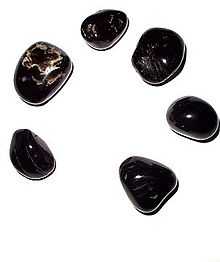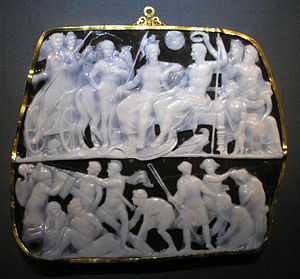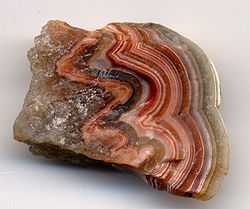Onyx
| Onyx | |
|---|---|
|
A slice of sardonyx (width = 2.5 cm) | |
| General | |
| Category | Oxide mineral |
| Formula (repeating unit) | Silica (silicon dioxide, SiO2) |
| Identification | |
| Formula mass | 60 g / mol |
| Color | Various |
| Crystal system | Trigonal |
| Cleavage | Absent |
| Fracture | Uneven, conchoidal |
| Mohs scale hardness | 6.5–7 |
| Luster | Vitreous, silky |
| Streak | White |
| Diaphaneity | Translucent |
| Specific gravity | 2.55–2.70 |
| Optical properties | Uniaxial/+ |
| Refractive index | 1.530 to 1.543 |
| References | [1][2] |
Onyx is a banded variety of chalcedony. Agate and onyx are both varieties of layered chalcedony that differ only in the form of the bands: agate has curved bands and onyx has parallel bands. The colors of its bands range from white to almost every color (save some shades, such as purple or blue). Commonly, specimens of onyx contain bands of black and/or white.[3]
Etymology
Onyx comes through Latin (of the same spelling), from the Greek ὄνυξ, meaning "claw" or "fingernail". With its fleshtone color, onyx can be said to resemble a fingernail. The English word "nail" is cognate with the Greek word.[4]
Varieties


Onyx is formed of bands of chalcedony in alternating colors. It is cryptocrystalline, consisting of fine intergrowths of the silica minerals quartz and moganite. Its bands are parallel to one another, as opposed to the more chaotic banding that often occurs in agates.[5]
Sardonyx is a variant in which the colored bands are sard (shades of red) rather than black. Black onyx is perhaps the most famous variety, but is not as common as onyx with colored bands. Artificial treatments have been used since ancient times to produce both the black color in "black onyx" and the reds and yellows in sardonyx. Most "black onyx" on the market is artificially colored.[6][7]
Imitations and treatments
The name has sometimes been used, incorrectly, to label other banded lapidary materials, such as banded calcite found in Mexico, Pakistan, and other places, and often carved, polished and sold. This material is much softer than true onyx, and much more readily available. The majority of carved items sold as "onyx" today are this carbonate material.[8][9]
Artificial onyx types have also been produced from common chalcedony and plain agates. The first-century naturalist Pliny the Elder described these techniques being used in Roman times.[10] Treatments for producing black and other colors include soaking or boiling chalcedony in sugar solutions, then treating with sulfuric or hydrochloric acid to carbonize sugars which had been absorbed into the top layers of the stone.[7][11] These techniques are still used, as well as other dyeing treatments, and most so-called "black onyx" sold is artificially treated.[12] In addition to dye treatments, heating and treatment with nitric acid have been used to lighten or eliminate undesirable colors.[7]
Geographic occurrence
Onyx is a gemstone found in various regions of the world including Argentina, Australia, Brazil, Canada, China, Czech Republic, Germany, India, Madagascar, the UK, and various states in the US.[1] Onyx is formed in the vesicles of lava.
Historical usage

It has a long history of use for hardstone carving and jewellery, where it is usually cut as a cabochon or into beads. It has also been used for intaglio and hardstone cameo engraved gems, where the bands make the image contrast with the ground.[13] Some onyx is natural but much of the material in commerce is produced by the staining of agate.[14]
Onyx was used in Egypt as early as the Second Dynasty to make bowls and other pottery items.[15] Use of sardonyx appears in the art of Minoan Crete, notably from the archaeological recoveries at Knossos.[16]
Onyx is mentioned in the Bible at various points.
Onyx was known to the Ancient Greeks and Romans.[17] The first-century naturalist Pliny the Elder described both type of onyx and various artificial treatment techniques in his Naturalis Historia.[10]
Slabs of onyx (from the Atlas Mountains) were famously used by Mies van der Rohe in Villa Tugendhat at Brno (completed 1930) to create a shimmering semi-translucent interior wall.[18]
See also
References
- ↑ 1.0 1.1 Onyx on Mindat.org
- ↑ Gemdat.org
- ↑ Lavinsky, Rob. "Onyx". mindat.org. Retrieved June 10, 2014.
- ↑ Etymology Online - Onyx
- ↑ Assaad, Fakhry A.; LaMoreaux, Philip E. Sr. (2004). Hughes, Travis H., ed. Field Methods for Geologists and Hydrogeologists. Berlin, Heidelberg, New York: Springer-Verlag. p. 8. ISBN 3-540-40882-7.
- ↑ Sinkankas, John (1959). Gemstones of North America 1. Princeton, New Jersey: Van Nostrand. p. 316.
- ↑ 7.0 7.1 7.2 "The Manufacture of Gem Stones". Scientific American (New York, New York: Munn & Company): 49. 25 July 1874.
- ↑ Profile of onyx
- ↑ Hurlbut, Cornelius S.; Sharp, W. Edwin (1998). Dana's Minerals and How to Study Them (4th ed.). New York, New York: Wiley. p. 200. ISBN 0-471-15677-9.
- ↑ 10.0 10.1 O'Donoghue, Michael (1997). Synthetic, Imitation, and Treated Gemstones. Boston: Butterworth-Heinemann. pp. 125–127. ISBN 0-7506-3173-2.
- ↑ Read, Peter G. (1999). Gemmology. Oxford: Butterworth-Heinemann. p. 160. ISBN 0-7506-4411-7.
- ↑ Liddicoat, Richard Thomas (1987). Handbook of Gem Identification (12th ed.). Santa Monica, California: Gemological Institute of America. pp. 158–160. ISBN 0-87311-012-9.
- ↑ Kraus, Edward Henry; Slawson, Chester Baker (1947). Gems and Gem Materials. New York, New York: McGraw-Hill. p. 227.
- ↑ Liddicoat, Richard Thomas; Copeland, Lawrence L. (1974). The Jewelers' Manual. Los Angeles, California: Gemological Institute of America. p. 87.
- ↑ Porter, Mary Winearls (1907). What Rome was Built with: A Description of the Stones Employed. Rome: H. Frowde. p. 108.
- ↑ C. Michael Hogan (2007) Knossos fieldnotes, The Modern Antiquarian
- ↑ International Colored Gemstone Association: Onyx
- ↑ http://www.tugendhat.eu/the-building/the-interiors.html; http://whc.unesco.org/en/list/1052
External links
| Look up onyx in Wiktionary, the free dictionary. |
| Wikimedia Commons has media related to Onyx. |
| ||||||||||||||||||||||||||||||||||||||||||||||||||||||
| ||||||||||||||||||||||||||||||||
